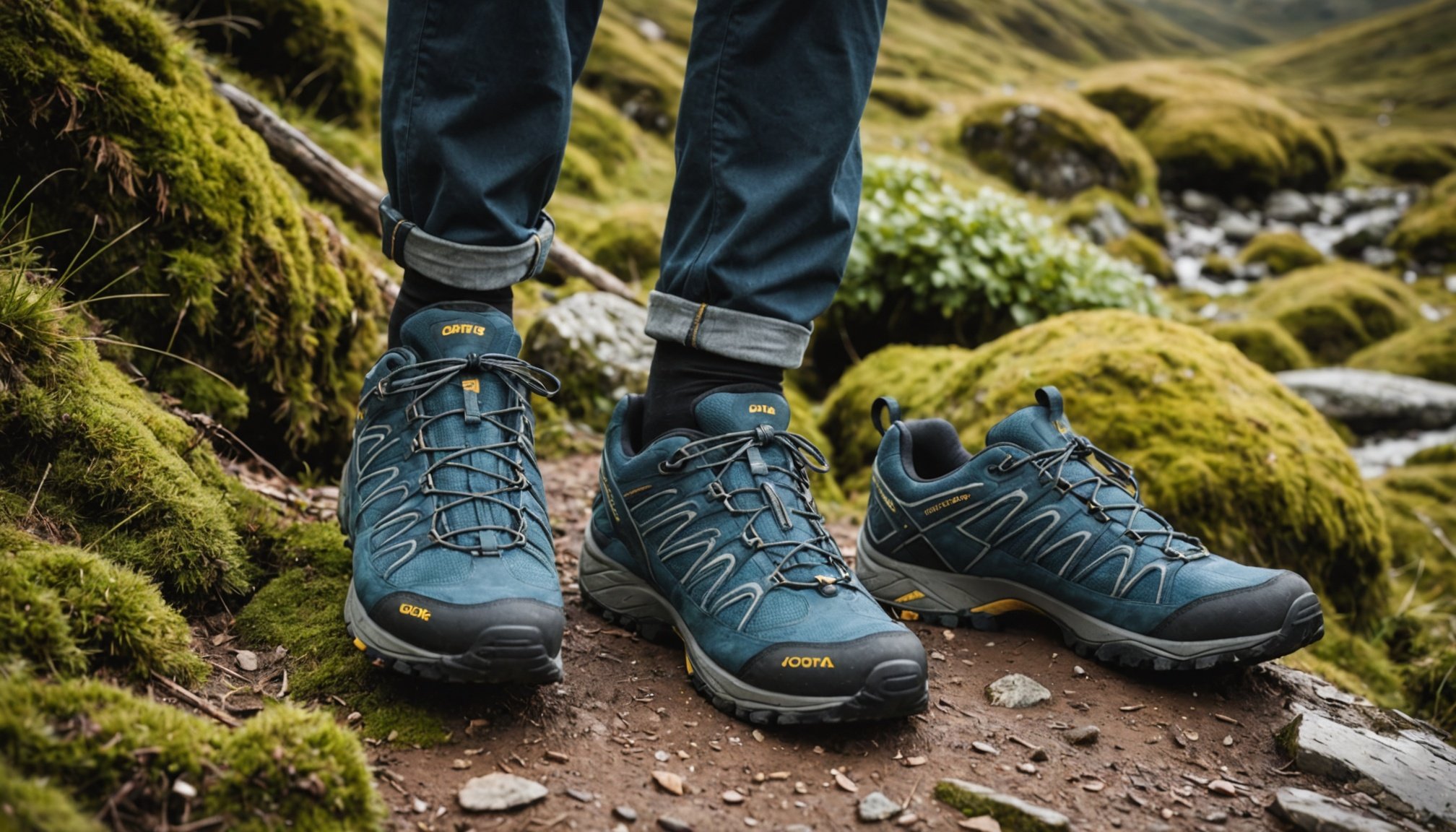Understanding UK Terrains
The UK’s diverse terrains create an adventurous playground for outdoor enthusiasts. From rolling hills and expansive moors to serene valleys, each landscape offers unique challenges and splendor. Navigating these terrains efficiently requires an understanding of terrain classification, which can influence the choice of gear, particularly footwear.
Importance of Footwear
Selecting appropriate footwear is crucial when exploring diverse UK terrains. For instance, trail shoes offer stability on rocky paths, while boots provide essential support for muddy moors. Different terrains demand varied traction, cushioning, and durability to ensure comfort and prevent injuries.
Also to see : Elevate your everyday fashion: unique style transformations for uk music festivals
Terrain Impact on Performance
Terrain types directly influence shoe performance. Hills may require enhanced grip due to inclines, while moors need shoes with superior waterproofing due to their wet nature. Proper footwear adapts to these demands, lending safety and efficiency.
Understanding these nuances ensures a more enjoyable and safer outdoor activity experience, allowing you to fully embrace the diverse landscapes the UK has to offer while maintaining comfort and protection throughout your adventures.
In parallel : Chic commute: mastering fashion-forward outfits for long journeys in london
Types of Footwear
When it comes to footwear types, understanding the variety available can help you make informed choices for your adventures. From hiking boots to walking shoes, each type offers unique benefits tailored to specific needs and environments.
Trail runners are designed for those who enjoy a lightweight, yet durable option, ideal for running on uneven or rugged terrain. These shoes provide excellent traction and flexibility, allowing for agility and speed on trails. However, they may lack the ankle support found in more robust alternatives.
Hiking boots, on the other hand, are perfect for tackling rough, rocky landscapes. They offer superior ankle support and are crafted to withstand challenging conditions, making them the go-to choice for serious hikers. Their durability comes from high-quality materials that can handle heavy use, though this often means they are heavier and less flexible.
For more everyday scenarios, casual shoes are designed to provide comfort and versatility. These are suitable for urban walking and general wear, offering moderate support and cushioning. While not designed for intense outdoor activities, they excel in comfort for daily tasks. Comparing these options, durability, comfort, and support vary significantly, catering to diverse user preferences and activities.
Essential Features in Footwear
Choosing the right footwear features is crucial for both comfort and function, especially in the UK’s famously unpredictable weather. One paramount feature is waterproofing. Given the frequent rainy conditions, footwear with waterproof capabilities keeps feet dry and comfortable, significantly enhancing the user experience.
When considering sole traction and tread patterns, these elements fundamentally impact performance across different surfaces. A well-designed tread not only provides better grip but also ensures stability, whether you’re navigating slick pavements or rugged trails. This feature becomes indispensable for ensuring safety and preventing slips, which can lead to injuries.
Moreover, ankle support and cushioning play a vital role in user comfort and safety. Proper support stabilises the ankle, reducing the risk of strains or sprains during extended use or vigorous activity. Good cushioning absorbs shock, offering relief on hard surfaces, thus preventing fatigue and discomfort. These features are not merely preferential but integral for all-day wear and support, ensuring that each step is cushioned and stabilised effectively.
In conclusion, careful consideration of these footwear features ensures both performance and comfort in various conditions.
Recommendations for Specific Activities
When it comes to footwear recommendations for various outdoor activities, it is crucial to consider both the type of activity and the seasonal conditions. Different activities demand distinct levels of support, durability, and comfort from your footwear.
For day hikes, lightweight hiking shoes or trail runners from brands like Merrell or Salomon offer great support and grip without feeling cumbersome. These are ideal for warmer weather conditions, providing breathability and flexibility.
For long-distance treks, more robust hiking boots are recommended. Brands such as Scarpa or Lowa offer models with excellent ankle support and waterproofing, essential for tackling rugged terrains or wet conditions.
When engaging in casual walks, a comfortable and versatile option could be a pair of trail sneakers from Columbia or Nike. These provide a balance between comfort and durability, making them perfect for urban exploration or light nature trails.
Seasonal variations must be considered—opt for waterproof and insulated footwear during winter, while breathable and moisture-wicking designs are better suited for summer. Investing in well-suited footwear ensures both safety and comfort during your outdoor activities, enhancing your overall experience.
Tips for Fitting and Care
Finding the right shoe fitting can significantly enhance both comfort and performance. Start by measuring your feet using a Brannock device, as foot size can change over time. Additionally, try on different styles, as each shoe brand may vary in fit. Always test shoes at the end of the day when your feet are slightly swollen to ensure the best fit.
Breaking in new shoes is essential to prevent blisters and discomfort. Gradually wear them for short periods, increasing time progressively. Thicker socks can also aid in cushioning during this process.
To prolong your footwear’s lifespan, regular maintenance is crucial. Begin by cleaning your shoes with appropriate products based on their material—like a mild soap solution for leather. Consistent cleaning removes dirt and prevents material degradation. Proper storage is equally important. Keep shoes in a cool, dry place, using shoe trees to maintain shape. Rotate your shoes to allow them to air out between wears.
Such maintenance tips not only preserve shoes’ aesthetics but also ensure they continue offering the necessary support. Adopting these practices can save you money and improve your walking comfort markedly.
Visual Aids and Comparisons
Visual aids, such as charts and infographics, play a crucial role in footwear comparisons. They provide a clear overview of features and specifications, making it easier to differentiate between shoe types. For instance, a chart can effectively illustrate the differences in support and cushioning between running shoes and hiking boots. Informative graphics serve not only to clarify but also to visually engage the reader, offering a memorable and intuitive understanding of complex information.
In addition to technical specs, integrating user reviews and ratings enriches these comparisons. Such feedback helps to ground the data in real-world experiences, presenting a nuanced picture of the shoes’ performance. When customers see a strong alignment between informative graphics and positive user reviews, their confidence in making a decision significantly increases.
Furthermore, including images of varying terrains alongside suitable footwear reinforces recommendations. For example, a rugged mountain landscape paired with a sturdy hiking boot visual clearly communicates the shoe’s ideal environment. This synergy between visual and textual information ensures that readers make informed and confident footwear comparisons.











